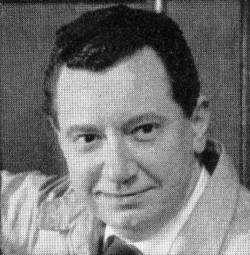
Atlas photoflash advertisement
(Colour Photography magazine, Sept-Oct 1965)
Kevin (Patrick) MacDonnell (Mac) was born in County Mayo, Ireland, 25th November 1919. He died while living in North London, April 2001 (registered at Camden; Ref: GRO Death Index). He was a freelance photo-journalist whose name originally came to my attention when, with 'Pip' Pippard, he authored the 'Home Photography' series of booklets for Johnsons of Hendon and I acquired a copy of the 4th Edition in the late 1950s.
In the Atlas photoflash advert (see picture, left) he was described as a photographic journalist and television broadcaster, plus a press, advertising and theatrical photographer.
Kevin had articles published in various magazines but was especially a regular contributor to 'Photography' magazine from the 1950s through to (at least) the early 1980s. His light-hearted column was called 'Roundabout' during the 1960s but by the 1980s was simply headed 'Kevin MacDonnell'.
There was a break in his contributions to 'Photography' for around 2 years from mid-1965 but in the July 1967 edition there is a short notice entitled 'Kevin Rides Again...' where the magazine announces the return of his column saying "Kevin's inimitable style endeared him to his readers; yet his material was packed with sound advice." His new column replaced one by John Heron, called 'Talking Photography'.
The following few paragraphs were written by Kevin to introduce himself to new readers of 'Photography'. The picture, below, left, dates from that 1967 entry.
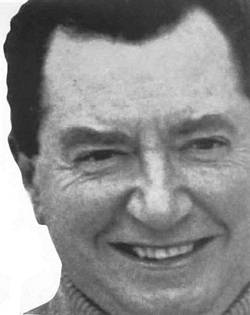
"I came from Mayo (west side of Ireland) but was educated in England - partly at public school but mainly at various poker schools in Fleet Street (used to be the London newspaper capital of the UK), where I worked for several magazines and agencies. Perhaps my happiest memories of those days was when Hitler, after a prolonged scrutiny, personally refused me permission to take his picture!
After the war I ran a Technical Film Unit for an aircraft company, spending my time test flying and filming every aspect of aircraft design. I then married Sheila Darragh (registered in Hampstead, 3rd Quarter of 1950) the aeronautical engineer, and have lived happily ever after. I look forward to writing again for 'Photography' magazine."
'Photography' magazine continues "Kevin has done much theatrical photography and a great deal of advertising work. His lecture tours have taken him to all parts of Britain, and many readers will remember his TV series - a medium which he thinks ideal for introducing photography to the public. Few people can have such a sensitive finger on the pulse of photography as Kevin MacDonnell. He may appear to take things lightly but there is always hard common sense in anything he writes. Having him back appeals to us, too, and, we are sure, to many of our readers. Meet Kevin in the August (1967) issue of this magazine. We know you are going to enjoy your 'rides' on - 'Roundabout'."
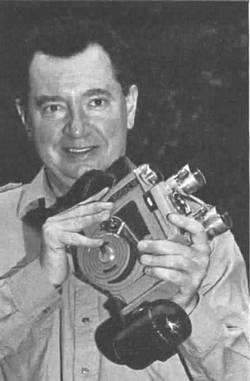


names Kevin's daughter as Kieron, but Kieran is believed to be correct.

Kevin and Sheila lived at Hampstead for a number of years. In Photography magazine, January 1981, he uses the above picture during his test of Ilford XP-1 400 film. He writes "I crossed to the other side of Hampstead Ponds by means of the causeway and turning round took a picture of the rather odd area where we live."
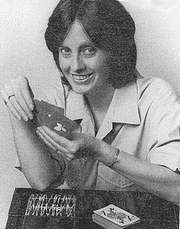
This Photography magazine picture seems to be of Kevin's daughter Kieran, in 1981.
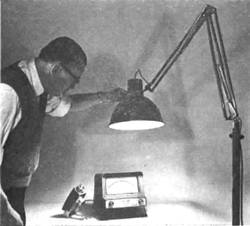
Kevin with newly developed 'Swinglite'.
It was reviewed in the 'What's New?' section of Amateur Photograper for 26th June 1968. "A 500watt studio flood...height and angle can be easily adjusted."
Geoff Nyburg also relates that Kevin fought with the International Brigade during the Spanish Civil War (1936-1939) assisting the democratic government against Nationalist forces, led by General Franco and assisted by Nazi German and Fascist Italian forces.
During the 1960s Geoff understands Kevin was working on a biography of Michael Collins.
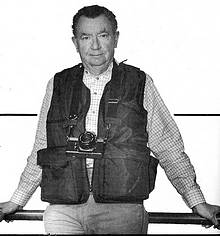
Kevin in 1982, modelling 'The Photographer's Waistcoat',
offered at £39.95 incl.p&p to Photography readers.
Apart from the 'Home Photography' series of books which Kevin MacDonnell co-authored with A.R.Pippard, and the book 'Choosing and Using SLR Lenses' illustrated below my 'Home Photography' collection, Kevin MacDonnell authored or co-authored several others, incl:
- "Better Photography"
- "35mm Camerman"
- "Eadweard Muybridge: the Man Who Invented the Moving Picture" (see the paragraphs below)
- "Freelance Photographers' Britain"
- "Eric Hosking's Birds : fifty years of photographing wildlife" (with Eric John Hosking)
- "A Photographer's Guide to Kent"
- "A Photographer's Guide to Sussex"
- "Looking Back At Transport 1901-1939"
- "A Photographer's Guide to London"
- "Freelance Photographers' Britain (How to shoot & sell pictures of the British Isles)"
Amazon show many of the above, together with colour photographs of their covers.
On the subject of Kevin's book
entitled "Eadweard Muybridge: the Man Who Invented the
Moving Picture", Richard Gee in Photography magazine
for April 1973, wrote:
First Movement:
Our popular columnist Kevin MacDonnell is at last able to sit
back and enjoy the result of many long hours of toil and sweat.
His new book, "Eadweard Muybridge: The man who invented
the moving picture", was published by Weidenfeld & Nicolson
on March 1st.
If the title smacks of Spike Milligan, the book certainly does
not. It is a unique and fascinating study of a man who, in the
late 19th century, astonished the world by producing the first
moving picture - achieved by lining up twelve cameras and placing
the resulting photographs on to a revolving disc. But that's
only one of the many facets of Muybridge's work. The reader will
find that all is revealed in the hundreds of illustrations. I
think it's a great book ... by a great writer.
Kevin, in his 'Roundabout'
pages for Photography magazine, April 1973, wrote:
Muybridge Revived:
so Weidenfeld & Nicolson have finally published my book on
Muybridge, possibly the greatest all-round photographic genius
this country has yet produced. It seems a long time ago that
I first realised that he was almost unknown in England and decided
to do something about it; a handful of people knew that he had
photographed trotting horses, but that seemed to be the limit
of their knowledge.
Yet Muybridge was the first person to show moving pictures on
a screen to an audience; he invented an electronic shutter in
1878 and a document copying system in the same year; he designed
a twelve-lens camera for analysing animal and human movement;
he perfected the art of adding clouds to blank skies and of making
'moonlight' pictures.
Above all, he was a photographer who, using wet collodion plates
that had to be coated and developed on the spot and huge cameras
that were carried by pack mules, turned out strangely modern
and exciting pictures, the kind of thing that might be taken
by a highly-skilled photojournalist today. I have never seen
any travel pictures yet that could equal his Central American
landscapes or action shots that were more interesting or amusing
than his extraordinary series of the students and graduates of
Penn University in the nude (one example shown below).
Muybridge was born in Kingston-on-Thames, which may explain why
so many American historians minimise his achievements, just as
they do with those of Friese-Greene, the inventor of the moving
film we use today. Admittedly, both were rather odd characters
and Muybridge, especially, earned the reputation in California
of being 'eccentric'. If one of his bills was questioned, he
would refuse payment. If someone admired one of his possessions,
he gave it to him. When in jail for murdering his wife's lover,
he threatened an astonished 'Old Lag' with violence for using
coarse language in his presence and took a Chinese, who was being
ill-treated, under his protection (he was a big, powerful man).
In other words, he was a kind of Yankee at the Court of King
Arthur in reverse.
Yet when, against the ruling of the judge, the jury acquitted
him of the murder on the grounds that they'd have done the same
thing themselves, crowds gathered outside the courthouse to cheer
him. He seemed to be liked by everyone, from savages in the jungle
up to (or down to, depending on your viewpoint) the Royal Families
of Europe.
Oddly enough, his influence on artists was even greater than
that on photographers. Pre-Muybridge, painters had depicted horses
in attitudes that made them look like rocking horses, but once
his high-speed pictures had been published, every artist in the
world realised they were wrong and changed their techniques.
Almost any painting that depicts the movement of a horses legs
inaccurately, can be dated to a period before the publication
of his first results.
Muybridge was a kindly, honourable, man whose life sounds incredible
when you come to write it down. Murder, sex, violence, cowboys
and Indians, travel, inventions, High Society, primeval jungles
and throughout it all, a staggeringly high output of superb photographs.
I hope my book will do something to compensate for the neglect
of years; perhaps the good people of Kingston will even put up
some kind of plaque in his memory.

|
|
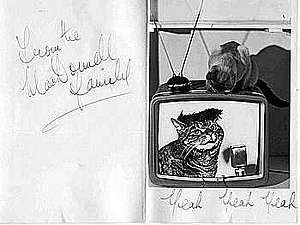
The script on the front of the card reads:
"A Beatle for Xmas" and the text on the LHS reads "From the MacDonnell family". The cat in the TV picture has a typical Beatles hair style and is saying 'Yeah, Yeah, Yeah' as in the lyrics of the Beatle's 'hit' 'She Loves You'.
Jill Howell, who runs 'Photographic Books' and is a member of the PCCGB, kindly sent me a scan of a Christmas card (alongside) she came across within a parcel of photographic items from the estate of Neville Maude, Technical Editor of Amateur Photographer (AP) magazine in the 1960s.
The joke appears to be a combination of two factors:
- Kevin MacDonnell and members
of AP staff appeared on TV during the early years of the Beatles
'pop' group becoming famous. Stephen Batey recollects that Kevin
co-presented a television programme on photography in the 1960s
with Reg H Mason (M.A; F.I.I.P; F.R.P.S) the (then) Editor of
Amateur Photographer (AP) magazine.
Reg Mason, born 1915, died 3rd June 1991. He was editor of AP from 1963 to 1976 and had been consultant art editor from 1946 until 1963.
- Jon Pippard recalled that it was a long-standing Christmas card joke of Kevin's that every year his family's cats appeared in a variety of more and more impossible and often topical poses. Jon says, "As a child I was always keen to see what Kevin's cats were up to 'this' year!"